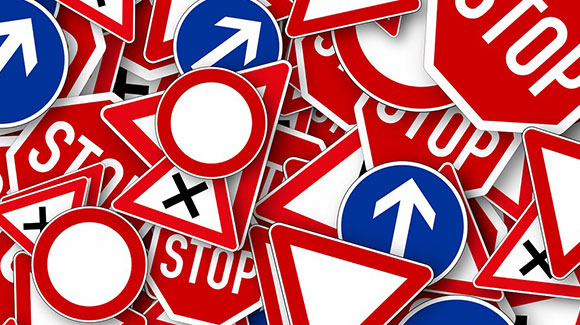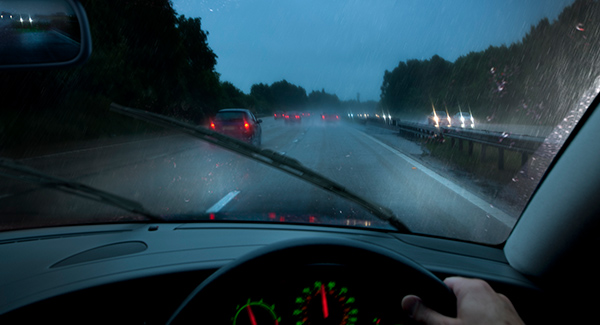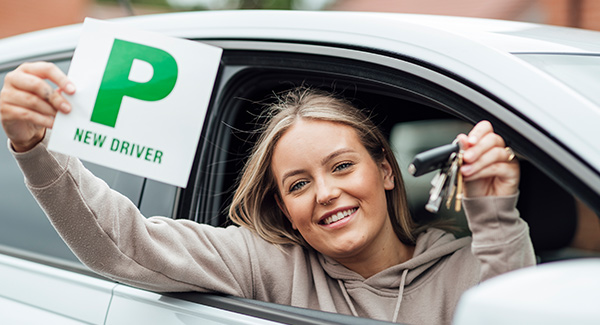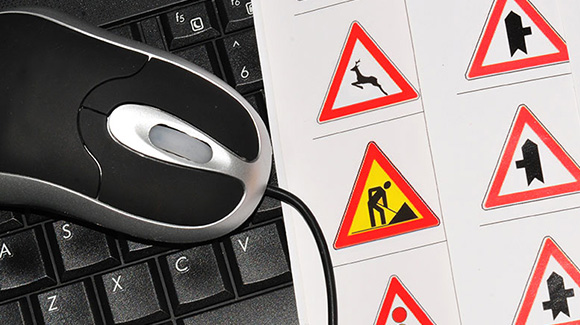How To Pass The Theory Test
- Editorial Team
Passing your theory test is the first step in becoming a full UK driving licence holder. But more than half of learner drivers that sit the test fail it. Therefore, preparing properly for the theory test is so important.
In this guide we’ve put together our tips to help you pass your theory test like a pro.
The driving theory test consists of two parts, multiple choice questions and a hazard perception test. You need to pass both parts to pass your theory test and you cannot book your practical driving test until you’ve passed.

What can I use to revise for the theory test?
There are a wide range of resources you can use when studying for your theory test.
The questions in the multiple-choice part of the theory test are based on The Highway Code, Know Your Traffic Signs and Driving or Riding, the Essential Skills. So, use these revision materials when preparing for your theory test. More information on each is provided below.
The Highway Code
The Highway Code covers England, Scotland and Wales. It provides information, guidance, advice and rules for road users to help keep them safe.
Know Your Traffic Signs
Traffic signs give instructions, warnings or information to road users to help make the roads as safe as possible for everyone. So, knowing what each traffic sign means is essential.
Know Your Traffic Signs is a guide for all road users that explains the importance of each traffic sign and helps to keep your knowledge of traffic signs up to date.
The Essential Skills
Driving – The Essential Skills book provides everything you need to know about safe driving or riding. It is recognised as the industry standard driving manual.
Take a practice theory test
You can also take a practice theory test on GOV.UK or take the A Choice practice theory test to put your knowledge of the road to the test. Both consist of 50 multiple-choice questions based on The Highway Code.
The questions are not used in the actual driving theory test but are based on the same topics as the test.
Take a practice hazard perception test
You can take a practice hazard perception test. There are 3 clips that feature everyday road scenes. You need to score 9 points or more to pass.
How to revise for theory test
Trying to cram everything in the day before your theory test is not an effective way to learn. You’ll put yourself under unnecessary pressure and stress and go into your test unprepared.
Overloading your brain with last minute cramming makes it harder to retain information. Whereas revising little and often allows you to re-learn and helps cement information into your long-term memory.
You can improve your chances of passing by preparing properly for the test. Creating a revision schedule will help you to use your revision time effectively. It will allow you to get plenty of rest and relaxation between sessions and ensure you’re not cramming all your revision in the night before your theory test.
There are no hard and fast rules when it comes to how much revision you should put in. Everyone learns at a different pace and some pick up things faster than others. But the DVSA recommends at least 20 hours of theory test revision.
Break down your revision into manageable sessions and keep your revision varied so that it stays fresh and engaging.
When revising for your theory test, try to capitalise on your most productive hours of the day. For instance, if you find that you’re more productive in the morning, plan your schedule in around morning learning.
To plan an effective revision programme, you’ll need to assess how confident you are on each topic. This will allow you to dedicate more time on the areas that need improving. For instance, if you’re struggling to learn road and traffic signs, you can dedicate more of your time to this topic.
Studying for hours will make you feel tired and affect your concentration. Allocate regular breaks into your revision schedule and remember to revise little but often.
Ask a friend or family member to help you with your revision. They can test you on what you’ve learned and help to keep you on track and organised.
Get a good night’s sleep
You want to be feeling at your best on the day of your theory test, so getting a good night’s sleep is essential. Good sleep can help maintain your attention and concentration levels. It improves your ability to learn new information and helps strengthen your memory.
Avoid caffeine
Avoid caffeine where possible before you go to bed. Caffeine is a stimulant that increases your heart rate and can disrupt your sleep.
Caffeine can be found in coffee, tea, chocolate, fizzy drinks and energy drinks. Excessive amounts of caffeine can also make you feel anxious and nervous.
Ditch the phone before bed
Try to avoid using your mobile phone in bed as this may affect the quality of your sleep. This is because the blue light emitted from the display screen on your phone may prevent your body releasing melatonin, a hormone which helps you sleep.
Deep breathing
Breathing exercises are a great way to reduce stress and anxiety before your theory test.
Find a quiet, comfortable place and begin by taking a normal breath, followed by a deep breath. Breathe in slowly through your nose and out through your mouth.
If you’re finding it hard to focus, try counting to 5 as you inhale, then without pausing or holding your breath, exhale counting to 5 again.
Breathing exercises only take a few minutes and can help to relax your body and clear your mind.
What to take to theory test?
You’ll need to take your UK photocard driving licence to the theory test.
If you do not have a photocard licence, you’ll need to provide your paper licence as well as a valid passport.
Your test will be cancelled, if you do not take the right documents with you to the test centre.
How long does a theory test take?
You have up to 1 hour and 20 minutes to complete the theory test. Ideally, you should be aiming to arrive at the test centre at least 30 minutes before you start. This will allow you time to familiarise yourself with the test format and equipment.
You can take up to 57 minutes to complete the first part of the theory test, which consists of 50 multiple-choice questions. Some people finish sooner, although you should always use the full amount of time to check over your answers carefully.
After completing the multiple-choice part of the theory test, you may take a short break of up to 3 minutes. Or you can go straight into the second part of the theory test, which covers hazard perception, this takes up to 20 minutes.
| Multiple choice | Up to 57 minutes |
| Short break | Up to 3 minutes |
| Hazard perception | Up to 20 minutes |
| Total time allowed | 1 hour and 20 minutes* |
* You should aim to arrive at least 30 minutes before the start of the test.
Multiple choice questions, tips on how to pass
The multiple-choice part of the theory test consists of 50 questions and you need to answer 43 questions correctly to pass. The questions are based on The Highway Code, know your traffic signs and Driving or Riding, The Essential Skills. You have 57 minutes to complete the test.
Read each question thoroughly before attempting to answer. Don’t just jump in with the answer even if you feel confident you know it. Review each possible answer option carefully.
Try to narrow down your options by eliminating the obvious wrong answers. Then focus on the remaining answers. Take your time and answer the question in your mind first, before submitting your answer.
If you’re unsure about a question, flag it for review and come back to it once you’ve answered all the questions you know. Make an educated guess if you’re not sure of the answer. Try rephrasing the question or thinking about related information that might lead you to the correct answer. If you feel that you’re spending too much time on one question, move onto the next.
You can review the questions and change your answers at any time during the test.
You can have a break of up to 3 minutes between the first and second part of the theory test.
Hazard perception, tips on how to pass
Once you’ve completed the multiple-choice part of the test, you’ll move on to hazard perception. This tests how well you can spot developing hazards from various road scenes. Developing hazards are things that would cause you to take action like changing speed or direction.
The tests consists of 14 clips. 13 of the clips have one developing hazard and one of the clips has two.
You need to click the mouse button as soon as you spot a developing hazard and up to 5 points are available for each. You’ll score more points for identifying a developing hazard earlier, so click as soon as you spot one.
Clicking repeatedly or following a click pattern will score you zero for the clip. But you won’t lose points for clicking on other things even if they don’t develop into a hazard.
To pass this part of the theory test, you need to score 44 points out of the 75 available.
Once you pass the theory test, you have two years to pass your practical driving test. Otherwise, you’ll need to take the theory test again.
What happens if I fail the driving theory test?
Whilst you may feel disheartened if you fail your driving theory test, the good news is that there is not limit on how times you can take the test. But you must wait at least 3 days before you can take the test again.
If you fail, you will get a letter at the test centre which provides details on the parts you did not score enough points on. This will allow you to dedicate more revision time on the parts that need improving. Remember, the test is hard with more than 50% failing the test, so if you do fail, focus on coming back stronger next time.
Final thoughts
The tips provided in this article will help you plan and prepare effectively for your theory test. Don’t forget to take your provisional licence with you to the test centre, otherwise you won’t be able to take the theory test.
Good luck!
Share this article
Table of Contents
More posts

Do Black Boxes Have Nighttime Driving Restrictions?

How To Give Your Vehicle A Spring Clean

Should You Take An Intensive Driving Course?


